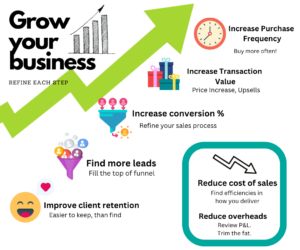Is your business in a tight spot and needs to save some money? In this article, we’ll help you with key strategies to stop cash from walking out the door and remain firmly in your pocket.
Business is a fairly simple game, make more than you spend and your cash in the bank will grow.
When your revenue drops one of the key levers you can pull is to shrink your expenses in order to stay profitable.
We encourage our clients to carry a ‘lean mindset’ even during profitable times, but as a business grows – its commitments will naturally grow alongside it.
We recommend a full expense review at least every 12 months, where you cast a critical eye over EVERY expense on your profit & loss and evaluate if it still is truly serving you.
For every expense in your business, ask yourself:
“Is spending this money creating value for my customer? Is this moving us towards our ultimate goal? “
Separate out the “nice to have” from the mission-critical “must-have”
See below for some areas to start hunting those savings:
- Avoid Long term commitments
Do not commit to any large long-term expenses if your revenue is unstable. Do you need that fancy office with a long lease and expensive fit-out? Do you really need to lease that car and run it through the business?
If you have some, can you renegotiate these? Practice the art of persuasion and look for a win-win.
- Review all of your recurring direct debit expenses
The ones that come out automatically and you forget about, or auto-renew every 12 months.
Software expenses are a very common area to save money. Founders get excited about that shiny software that will solve a problem and then the team struggles to use it regularly. Cut them out of your life immediately.
For anything you definitely need, perhaps look to purchase the annual plan and access the upfront discount.
One drastic way to do this is to actually cancel your current credit card and set up a new one.
Each time you get prompted about a missing payment – ask yourself if it’s truly worth recommitting to that expense.
- Review your current suppliers
Building good relationships with suppliers is critical to a stable business, but these need to be reviewed with a critical eye. Keep an eye out for better deals in the market.
Call vendors and negotiate your current deal. “I have been a loyal customer, paying on time for years. Can you help me out?”
In many cases, this can result in a discount as they do not want to lose a loyal customer, especially as good-looking as you.
If it does not, it often leads to an increase in value for the same investment you are making now.
At the very least you can ask for more favorable payment terms – perhaps they can extend your invoices to be due after 60 instead of 30 days? This really helps boost your cash flow.
- Do more with less
Question all of your current processes. Can you get the same result with less effort?
What is the MVP for your entire business model: from the product idea in your head through to collecting cash from customers?
Perhaps you have project management software that also tracks the time you can use, instead of paying for a separate time tracking system.
Explore other options and eliminate overlap – Technology is constantly evolving, and so are the accessible resources. You used to pay $30 for a Compact Disc of one album, now you can pay $15 a month for access to every artist in the world.
There may be a resource available for half the cost with greater capability to meet your needs.
Ask for references and do your due diligence in research.
- Manage your Staff Expenses
The first tip is to hire slowly and fire fast if someone is not working out. Ideally within their probationary period.
Hiring the wrong person has a HUGE negative impact on your profitability. Having to spend months of time training and getting them up to speed, buying them a new laptop, and paying recruiter fees only to have them not work out is a huge drag on your productivity & your bank balance.
In a downturn, many people put off any new hires and try to get better productivity out of the current team through tracking their time and monitoring utilization.
With your current team, perhaps some of the them would be happy to go down to a 4-day week?
Offer a one-off bonus to staff instead of a full payrise, which is a much longer-term commitment. At the very least, delay pay rises for a while until you can steady the ship.
Having to let people go is the last resort, and sometimes a necessary reality.
Announce this in the most thoughtful and compassionate way possible, as it has massive ramifications on internal culture and the morale of the remaining staff, especially if they have to pick up the slack.
Make sure the team understands why it had to happen, being as honest as possible about the state of the business.
- Stop Expense Creep into the future
Create systems to regularly track and verify expense success.
For many expenses, there is no actual direct return on investment and you can live without it.
For others, you just need to make sure it does not go above your assigned budget, and people are held accountable if it does.
The simplest way is to have a quarterly meeting with yourself and do a full review of the profit and loss to ensure you are staying lean.
You can also use tech solutions like Pleo, Expensify, Soldo, DiviPay, or Zoho Expense to get better oversight of spending and save cash.
If you need help with any of this, please get in touch and we would be happy to help.
We even have a free expense review template to help you get started.




